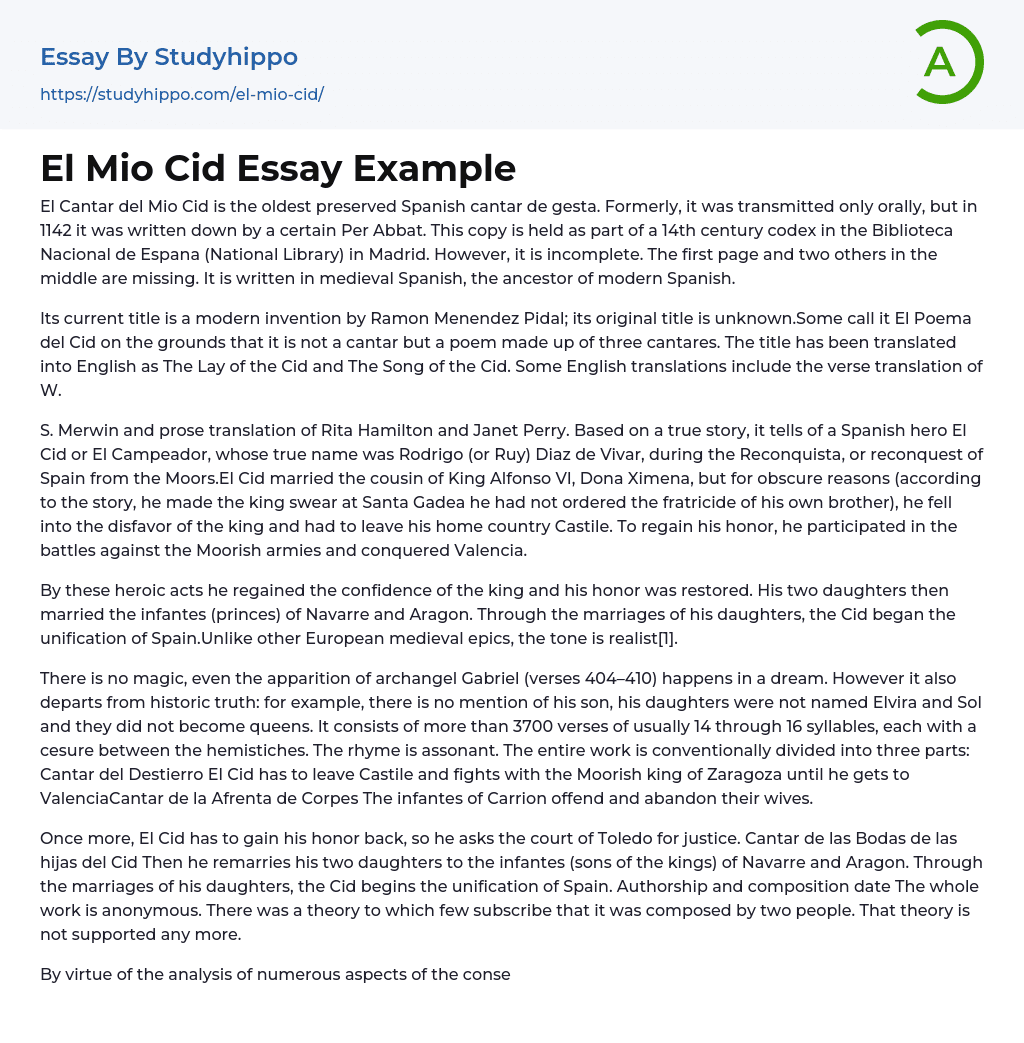The earliest recorded Spanish cantar de gesta, known as El Cantar del Mio Cid, was orally transmitted before being transcribed in 1142 by Per Abbat. The sole remaining copy is a 14th century codex located at the Biblioteca Nacional de Espana in Madrid; however, some pages are missing resulting in an incomplete version. The medieval Spanish language utilized within the text serves as an antecedent to modern-day Spanish.
The original title of the poem is unknown, but it has been given the modern title by Ramon Menendez Pidal. It is sometimes referred to as El Poema del Cid due to consisting of three cantares, not a single one. Variations of the title in English are The Lay of the Cid and The Song of the Cid. One version translated by W. is in verse fo
...rm.
The story of El Cid, also known as El Campeador, is based on true events and has been translated into prose by Rita Hamilton and Janet Perry. El Cid, whose real name was Rodrigo (or Ruy) Diaz de Vivar, played a significant role during the Reconquista, which was the reconquest of Spain from the Moors. El Cid married Dona Ximena, who was his cousin and also the cousin of King Alfonso VI. Despite this, he was banished from his home country Castile due to falling out of favor with the king. Although the reasons for his banishment are unclear in the story, it is said that he made the king swear at Santa Gadea that he had not ordered the fratricide of his own brother. In an effort to restore his honor, El Cid fought in battles against the Moorish armies
and ultimately conquered Valencia.
Having performed brave deeds, the Cid regained the trust of the king and his reputation was redeemed. As a result of these actions, his two daughters were wed to the infantes (princes) of Navarre and Aragon, and through these marriages, he began the process of unifying Spain. Unlike other European medieval epics, this narrative adopts a realistic tone[1].
Although the apparition of archangel Gabriel (verses 404–410) takes place in a dream, there is no magic involved. Nevertheless, the historical accuracy is not entirely preserved, as there is no mention of the protagonist's son and his daughters' names were not Elvira and Sol, nor did they become queens. The poem consists of over 3700 verses that typically contain 14 to 16 syllables and a cesure between the hemistiches. The rhyme is assonant. The Cantar del Destierro describes El Cid's departure from Castile and his battles with the Moorish king of Zaragoza until he reaches Valencia. On the other hand, the Cantar de la Afrenta de Corpes tells the tale of the infantes of Carrion who mistreat their wives and abandon them.
El Cid seeks justice from the court of Toledo in order to regain his honor, as described in Cantar de las Bodas de las hijas del Cid. He proceeds to arrange marriages between his daughters and the infantes of Navarre and Aragon, which marks the beginning of Spain's unification under his leadership. The authorship and composition date of this work remain unknown, with a theory previously suggesting that two individuals co-wrote it no longer supported.
After analyzing various aspects of the preserved text, it is evident that it was written by a sophisticated author
named Dona Elvira, who had extensive knowledge of the laws in effect during the late 12th century and principles of the 13th century. The writer was also familiar with the region bordering Burgos. The language used in the text suggests that the author was a lawyer who worked for a chancellery or as a notary for a nobleman or monastery. Their command of legal and administrative terminology is highly technical, and they also display expertise in several registers, including the proper style of medieval cantares de gesta.
- Boo Radley essays
- Genesis essays
- Richard iii essays
- Alice in Wonderland essays
- On the road essays
- Ozymandias essays
- The Nightingale essays
- Holden Caulfield essays
- Animal Farm essays
- 1984 essays
- A Hanging essays
- Shooting An Elephant essays
- A Tale Of Two Cities essays
- Adventures Of Huckleberry Finn essays
- Arthur Conan Doyle essays
- Brave New World essays
- Characters In Hamlet essays
- Characters In Romeo And Juliet essays
- Desdemona essays
- Diary Of A Wimpy Kid essays
- First-Person Narrative essays
- Frankenstein essays
- Heart Of Darkness essays
- Jane Eyre essays
- Jay Gatsby essays
- King Duncan essays
- Librarian essays
- Little Red Riding Hood essays
- Lord Of The Flies essays
- Silas Marner essays
- The Cask Of Amontillado essays
- The Catcher In The Rye essays
- The Crucible essays
- The Handmaid's Tale essays
- The Reader essays
- Virgil essays
- Wuthering Heights essays
- Candide essays
- Castle essays
- J. D. Salinger essays
- Ulysses essays
- Ethan Frome essays
- In Cold Blood essays
- Outliers essays
- Tuesdays With Morrie essays
- The Art of War essays
- Wife of Bath essays
- Huckleberry Finn essays
- The Lady With The Dog essays
- Great Expectations essays




